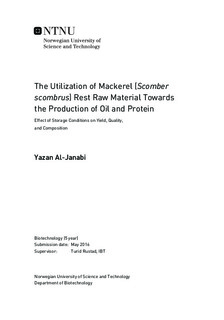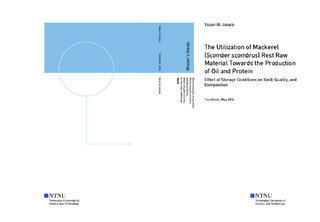| dc.description.abstract | Norway has a fishing and aquaculture industry which does not utilize the North Atlantic mackerel (Scomber scombrus) resource to the fullest of its potential. This means that large amounts of rest raw material produced after filleting is either discarded, or utilized for feed production in the aquaculture industry, and is in general underused. The rest raw material has great potential in the production of high quality biomolecules for human consumption, and is therefore a major incentive for research. Mackerel rest raw material contains high amounts of beneficial and healthy omega-3 fatty acids, as well as being rich in protein. These valuable biomolecules can have various applications within the food, pharmaceutical, and cosmetic industries.
An increasing trend in global population leads to an increasing need to produce more food. Therefore, the repurposing of already available resources to a more optimal production of high quality, high yield valuable products, is needed. Optimization of resource usage is paramount to global welfare.
The aim of this master thesis was to study the effect of rest raw material storage conditions on the yield, quality, and functional properties of the lipid and protein molecules extracted by thermal treatment and endogenous hydrolysis. The rest raw material from North Atlantic mackerel consisted of all parts of the fish, except the fillet. The rest raw material contained 17.9 % lipids, 12.7 % protein, and 3.2 % ash. The raw material was stored at either 4 or 10 °C for 0-120 hours, before being thermally treated for 15 minutes at 95 °C. The focus of the thermal treatment was towards the production of high quality, high yield products, i.e. crude marine oil and stickwater (protein). Quality parameters were also measured at an industrial standard.
Characterization of the chemical composition of the different rest raw material fractions, obtained from mackerel, was done on four different body parts; head, bellyflap, viscera, and backbone & tail. Lipid content was highest in bellyflap, 35 %, lowest in viscera 7-8 %, and between 15-20 % in head and backbone & tail. Protein content ranged between 12-17 %, lowest in bellyflap, and highest in backbone & tail. While ash content was highest in head and backbone & tail 4.1-4.2 %, and lowest in viscera 1.8 %.
The storage experiment conducted, was done with a mixture of all rest raw material fractions. Crude oil extracted by means of thermal treatment (95 °C, 15 min) was done post endogenous hydrolysis. The quality was high with respect to low peroxide value (PV), para-anisidine value (AV), and free fatty acid (FFA) content. The values obtained were well within the recommended limits for crude oil intended for human consumption, as long as the raw material was stored for 24 hours or less. Storage conditions play a major role in the quality of the crude oil, with respect to the total oxidation value (TOTOX). FFA levels increased with increases in storage time and were considerably higher in the raw material stored at 10 °C, as opposed to 4 °C. A correlation between storage conditions and oxidation status was found for several quality parameters. The crude oils oxidative stability was also analyzed, where increases in storage time and temperature lead to decreases in oxidative stability. Crude oil extracted from fresh raw material (0 hours of storage) had % FFA 0.5, PV 5.3 mEq/kg lipid, AV 1.0, TOTOX 11.6, and OSI 7.4 hours.
The yield of crude oil increased slightly in the first 24 h, and was consistently a little higher for raw material stored at 10 °C, as opposed to 4 °C. Stickwater yield increased slightly in the first 48 hours, then decreased marginally between 48-120 h. The temperature of storage did not seem to consistently influence the stickwater yield. However, it should be noted that if the temperature did play a role, the higher temperature did have marginally increased stickwater yield.
Sludge yield decreases in the first 24 h, which is explained by increases in both oil and stickwater yields simultaneously.
Stickwater was simultaneously extracted by thermal treatment, post endogenous hydrolysis. The protein content in the stickwater ranged between 78.3 % and 83.4 % (using a total % (N) to protein conversion factor of 6.25). The protein content of the stickwater was higher for raw material stored at 10 °C as opposed to 4 °C. A correlation was found between the protein content and the storage time, protein content increased in the first 24 h - 48 h, then plateaued or decreased slightly after 48 h. The decrease may be correlated to the degree of hydrolysis and the incorporation of lipids into the stickwater fraction due to increased emulsifying ability.
The molecular weight distribution (MWD) of the proteins, peptides, and amino acids present in the stickwater fraction was analyzed. The MWD suggested that increased storage time leads to more endogenous hydrolysis, resulting in the degradation of large molecules to smaller ones. Cleavage happens due to the presence of exo- and endo-proteases. The increased temperature of storage (10 °C) influenced the MWD by increasing the rate at which cleavage, by definition, hydrolysis proceeded. Higher temperature resulted in more rapid losses of concentration by large molecules, ultimately resulting in the rapid gain of concentration by the mid-range and small molecules.
Overall, yield and quality of crude oil and protein, were as expected, highly influenced by the raw materials storage conditions. However, the study has still shown that the production of high quality, high yield crude oil and protein from mackerel rest raw material is possible, and potentially very valuable. Challenges still remain in identifying the processes that mediate the high lipid content within the stickwater fraction, as well as dealing with the organoleptic properties (smell, taste, color) of the crude oil and protein products. The choice of process and storage condition is highly influenced by what the final product is intended for e.g. food industry, pharmaceuticals, or cosmetics. For the time being, with the challenges that exist for the production and processing of high quality mackerel rest raw material, production of crude oil might be the most feasible option. | |

